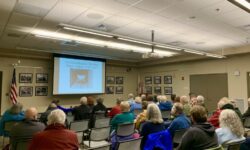By Amelia Tarallo
Hometown Weekly Staff
Each year, families gather around the table to share a Thanksgiving feast. Sometimes, the meal is filled with the warm feelings of being reunited with loved ones. Other times, it’s tense, and one phrase from exploding.
Whatever your Thanksgiving experience is, there’s a good chance that it’s going better than what led up to the first Thanksgiving in 1621.
On November 21, Christopher Daley, a history teacher out of Kingston, came to the Walpole Library to give library visitors a brief history of the pilgrims’ first year in New England with his presentation, “1620: First Year.” The presentation covered all things involved in that first year.
Daley began his presentation by sharing an interesting fact: “It’s the 400th anniversary of the Mayflower Compact,” he said. Though the date listed in primary sources is November 11, based on the old calendar, the modern calendar shifts dates ten days further, making it the 21st. During the presentation, dates were given in the old Julien style. After a brief explanation of different misconception of pilgrims - like the difference between Puritans and separatists - Daley launched into the meaty presentation.
With a goal of going to Virginia and arriving near an already-established colony, the pilgrims left England in July or August of 1620. They arrived in waters near Cape Cod on November 9. Because they weren’t in the colony of Virginia, they were no longer under the power of the British crown. In order to establish temporary control and to avoid a chaotic power vacuum, the men of the ship signed the Mayflower Compact.
On Monday, November 13, the pilgrims made their way to shore and began a series of both humorous and almost tragic events. Once on shore, the pilgrims spotted Native Americans, likely the Nausets. The pilgrims wanted to make contact with them to trade, but lost track shortly after spotting them. A group of men made the decision to explore the land and left their fellow pilgrims back at the boat. They traveled to an area known as Stout Creek, where, for the first time in months, the explorers had access to fresh water. Soon after, they sent a signal fire to tell their fellow Mayflower passengers that they were safe. They continued on, and according to the primary source “Mort’s Relation,” William Bradford, future governor of the Plymouth Colony, accidentally stepped onto a deer trap.
“They all thought it was funny to see him dangle,” said Daley, laughing with the audience. There were several expeditions about the area until the pilgrims finally moved to Plymouth to settle.
After seven days, the group arrived at Plymouth. In his presentation, Daley included a brief history of Plymouth Rock and how it somehow became a popular tourist attraction, despite it being tiny. “No matter what language they’re speaking, you know they’re saying ‘is that it?’” joked Daley about tourists seeing the rock. Though everyone seems to have their doubts about the rock, Daley noted that there is actually some legitimacy to the legend. In 1740, the prospect of a newly constructed wharf sent an elderly member of the Plymouth community into a panic. His father had told him that a rock there had been where the pilgrims had landed. With the man knowing many of the pilgrims personally, his claim was taken seriously. The rock was then split, and each part moved around, until coming back together at its current home.
As they settled, the pilgrims kept track of their Native neighbors, unsure what to do. On March 16, Samoset walked into the newly established village. For the first time since their arrival, the pilgrims were able to converse with a native person. However, Samoset delivered a concerning message: the nearby Native Americans were not happy with the settlers. By March 23, Massoit, leader of the Wampanoags, was meeting with John Carver, the governor. Together, the two worked out a treaty and agreed to be allies. The treaty lasted for half a century.
In November of 1621, the pilgrims celebrated their good harvest, along with their Native American allies who had helped them. By the time of the celebration, nearly half of the pilgrims had died from mysterious illnesses. The remaining members were grateful for all the help they had received from the Natives in steering through the difficult agricultural environment and the cold winter. Today, kids celebrate the holiday with paper turkeys and pilgrims, but never knowing the full story.






















